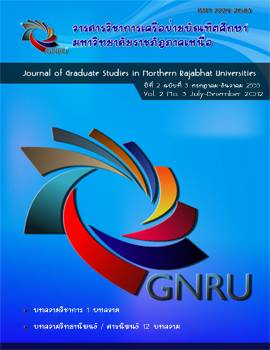การใช้ชุดเตรียมความพร้อมทางภาษาตามแนวการสอนภาษาธรรมชาติสำหรับเด็กปฐมวัย โรงเรียนบ้านแม่สะเต อำเภออมก๋อย จังหวัดเชียงใหม่
Main Article Content
Abstract
บทคัดย่อ
การวิจัยครั้งนี้มีวัตถุประสงค์ เพื่อสร้างและหาประสิทธิภาพชุดเตรียมความพร้อมทางภาษาตามแนว การสอนภาษาธรรมชาติสำหรับเด็กปฐมวัยและเพื่อศึกษาผลการใช้ชุดเตรียมความพร้อมทางภาษาตามแนว การสอนภาษาธรรมชาติสำหรับเด็กปฐมวัย กลุ่มตัวอย่าง ได้แก่ นักเรียนชั้นอนุบาล 2 โรงเรียนบ้านแม่สะเต จำนวน 9 คน เครื่องมือที่ใช้ในการวิจัยได้แก่ 1) คู่มือการจัดสภาพแวดล้อมในชั้นเรียนตามรูปแบบของการ สอนภาษาธรรมชาติ 2) แบบวัดความพร้อมทางภาษา 3) แผนการจัดประสบการณ์การเรียนรู้ตามแนวการสอน ภาษาธรรมชาติสำหรับเด็กปฐมวัย จำนวน 6 หน่วย 4) หนังสือนิทานเล่มใหญ่ 5) แบบสังเกตการเรียนรู้ทาง ภาษาของเด็กปฐมวัย และ 6) แบบฝึกทักษะทางภาษาตามแนวการสอนภาษาธรรมชาติ วิเคราะห์ข้อมูลโดย การเปรียบเทียบความแตกต่างของค่าเฉลี่ยความพร้อมทางการเรียนก่อนและหลังการจัดประสบการณ์โดยการ ทดสอบที และวิเคราะห์ประสิทธิภาพของชุดเตรียมความพร้อมทางภาษา แล้วนำไปเทียบเกณฑ์ 80/80
ผลการวิจัยพบว่า
1. ชุดเตรียมความพร้อมทางภาษาตามแนวการสอนภาษาธรรมชาติสำหรับเด็กปฐมวัย มีประสิทธิ ภาพเท่ากับ 81.54/94.41 สูงกว่าเกณฑ์ที่ตั้งไว้ คือ 80/80
2. ผลการใช้ชุดเตรียมความพร้อมทางภาษาตามแนวการสอนภาษาธรรมชาติ สำหรับเด็กปฐมวัย หลังจากทำกิจกรรมการเรียนรู้ครบ 6 หน่วยการเรียนรู้ เด็กมีความพร้อมทางภาษาหลังการจัดประสบการณ์สูง กว่าก่อนการจัดประสบการณ์ คิดเป็นร้อยละ 30.54 โดยมีคะแนนเฉลี่ยหลังเรียน (Posttest) เท่ากับ 43.44 คิด เป็นร้อยละ 90.50 และคะแนนเฉลี่ยก่อนเรียน (Pretest ) เท่ากับ 28.78 คิดเป็นร้อยละ 59.96
Abstract The purposes of this research were to construct and find out the efficiency of the instructional package on language readiness preparation based on the whole language approach for pre-school children of Ban Mae Sate School. The sample used in this study were 9 at Ban Mae Satae School, Omkoi District, Chiang Mai Province,who were second year pre-school students. The Tools used in the research were 1) the handbook for arranging the environment in the classroom in the form of natural language, 2) a largnge readiness measurement from according to whole language teching approach for preschool children before and after the experience,. 3. 6 unit of 30 learning experience plans along the natural language instruction for children, 4. big books of tales. 5. Observation for children language learning, . 6. Skilk practice forms according to whole language teaching approach the data wereanalyzed before and after learning through means and standard deviation. Comparison of mean differences was made in learning readiness before and after arranging the experience. Performance analysis of the whole language based readiness module wasmade and compared to the 80/80.
The results showed that
1. The language readiness preparation based on the whole language approach for pre-school children had an efficiency of 81.54/94.41, higher efficiency than the set criteron set of 80/80.
2. The implementation results of the whole language based readiness module for early childhood students aftercompleting all the actinties in 6 learning units revealed that language readiness of students after receiving the experience was 30.54 percent higher than that before receiving the experience, i.e. the post-tset meanwas 43.44 which was 90.50 percent wherwas the pretest mean was 28.78 which was 59.96 percent.


